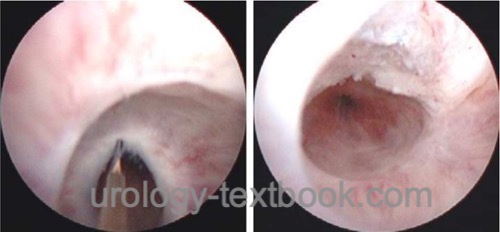You are here: Urology Textbook > Surgery (procedures) > Internal urethrotomy
Internal Urethrotomy
Review literature: (Pansadoro and Emiliozzi, 1998).
Indications for Internal Urethrotomy
Internal urethrotomy is the first therapeutic option to treat short urethral strictures without pronounced scarring.
Contraindications to internal urethrotomy
- untreated urinary tract infection
- Coagulation disorders
Surgical Technique of Internal Urethrotomy
Perioperative antibiotic prophylaxis
Internal urethrotomy should be done with sterile urine, any infection should treated with a full course of antibiotics. A perioperative antibiotic prophylaxis is often given, randomized studies for internal urethrotomy are missing. Patients with risk factors for a urinary tract infection benefit especially from an antibiotic prophylaxis. A perioperative antibiotic prophylaxis may reduce postoperative urinary tract infections, fever and may reduce the likelihood for recurrent urethral strictures.
Preoperative Preparations
The patient is placed in lithotomy position. Disinfect the external genitalia, the lower abdomen and the perineum and sterile draping. Spinal anesthesia or general anesthesia is needed for internal urethrotomy.
Direct-Vision Internal Urethrotomy
Direct-vision urethrotomy is the transurethral incision of the stricture under direct vision at 12 clock. The internal urethrotomy by Sachse uses a cold knife [fig. internal urethrotomy]. Alternatively, the stricture can be cut using a laser fiber (Nd:YAG or holmium). The incision of the urethral stricture should reach healthy tissue to minimize recurrent contraction of the scar.
 |
Blind Internal Urethrotomy (Otis)
An Otis urethrotomy is the blind transurethral incision of the urethra by an Otis urethrotome. After insertion of the Otis urethrotome, the urethra is dilated to the desired width and a blade cuts the stretched urethra at the 12 o'clock position.
The Otis urethrotomy is reserved for the palliative treatment of long-segment strictures of the male urethra or to treat proximal narrowing of the female urethra. Otis urethrotomy is also performed before the use of old resectoscopes (> 26 CH) in a narrow urethra to prevent ischemic damage. With modern 24 CH resectoscopes, this is rarely necessary.
Postoperative Management after Internal Urethrotomy
- Transurethral catheter for 2–7 days, depending on the length of the urethrotomy. Long-term catheterization up to six weeks did not manage to produce better results. Recurrent urethral obturation (by the patient) is the better choice to prevent recurrent urethral stricture.
- Control micturation with urinary flow and residual urine
- Perioperative antibiotic treatment
Complications of Internal Urethrotomy
- Recurrence of the stricture, see section urethral stricture for details.
- Bleeding: deep cuts with injury of the corpus spongiosum or corpus cavernosum may lead to strong bleeding, which can be stopped by inserting a properly sized catheter.
- Rare complications: erectile dysfunction due to injury of the erectile tissue, urinary incontinence due to injury to the urinary sphincter.
| Urologic Surgery | Index | Abbreviations |
Index: 1–9 A B C D E F G H I J K L M N O P Q R S T U V W X Y Z
References
Pansadoro und Emiliozzi 1998 PANSADORO, V. ; EMILIOZZI, P.: Die Urethrotomia interna.In: Urologe A
37 (1998), S. 21–24
 Deutsche Version: Urethrotomia interna
Deutsche Version: Urethrotomia interna